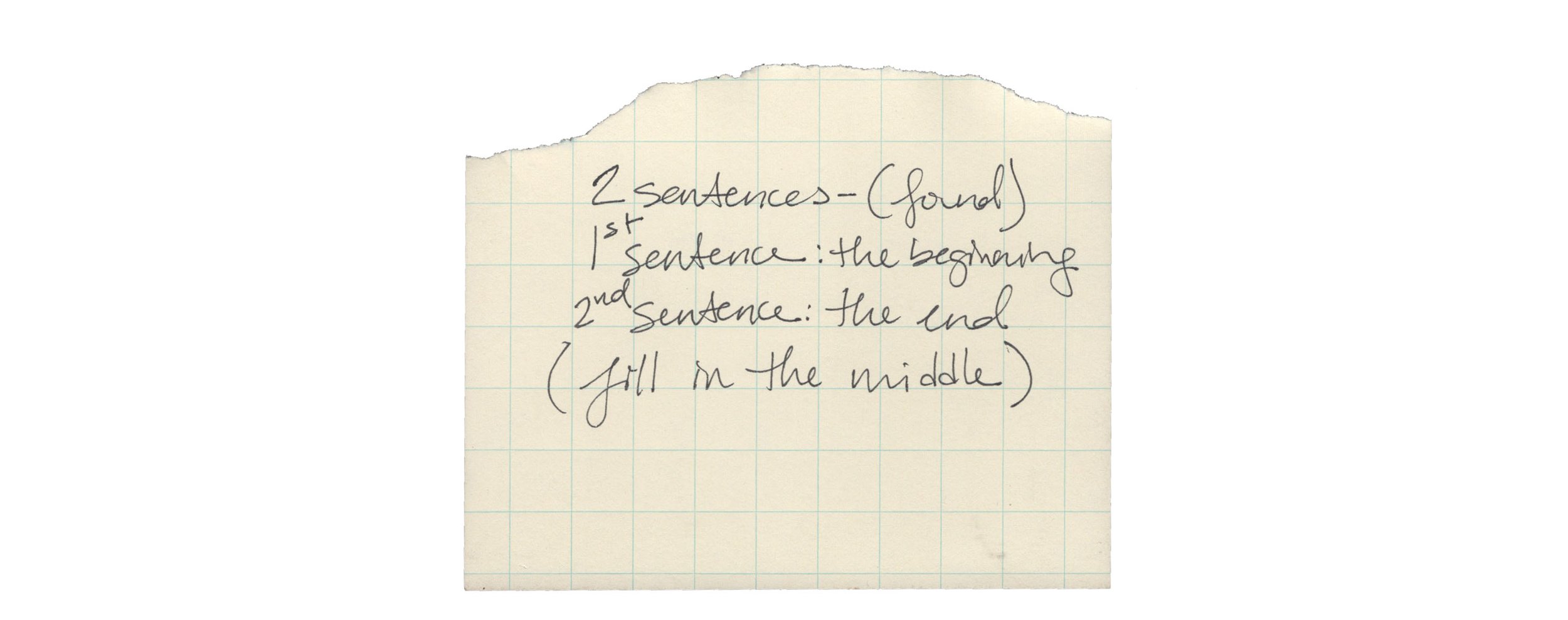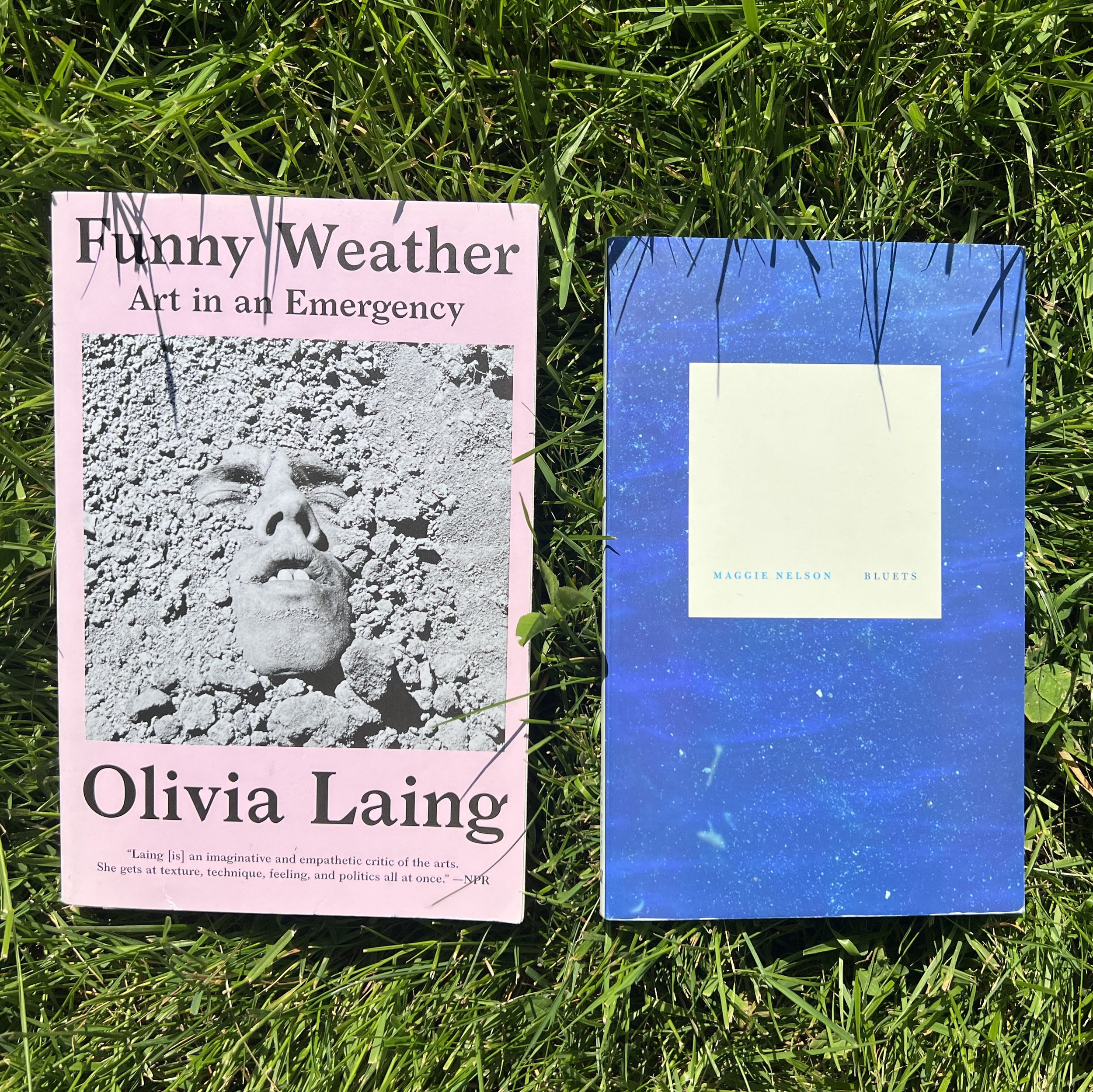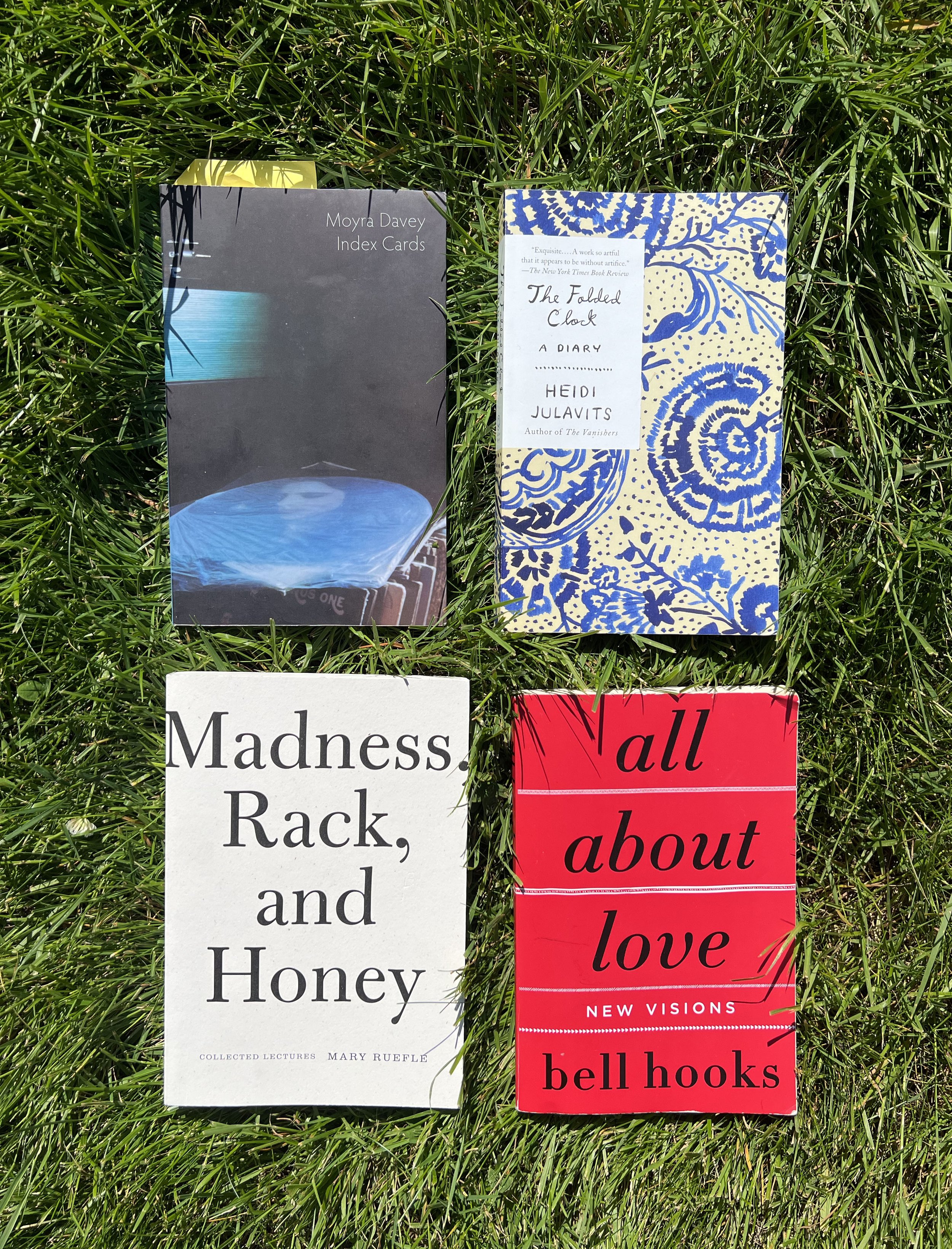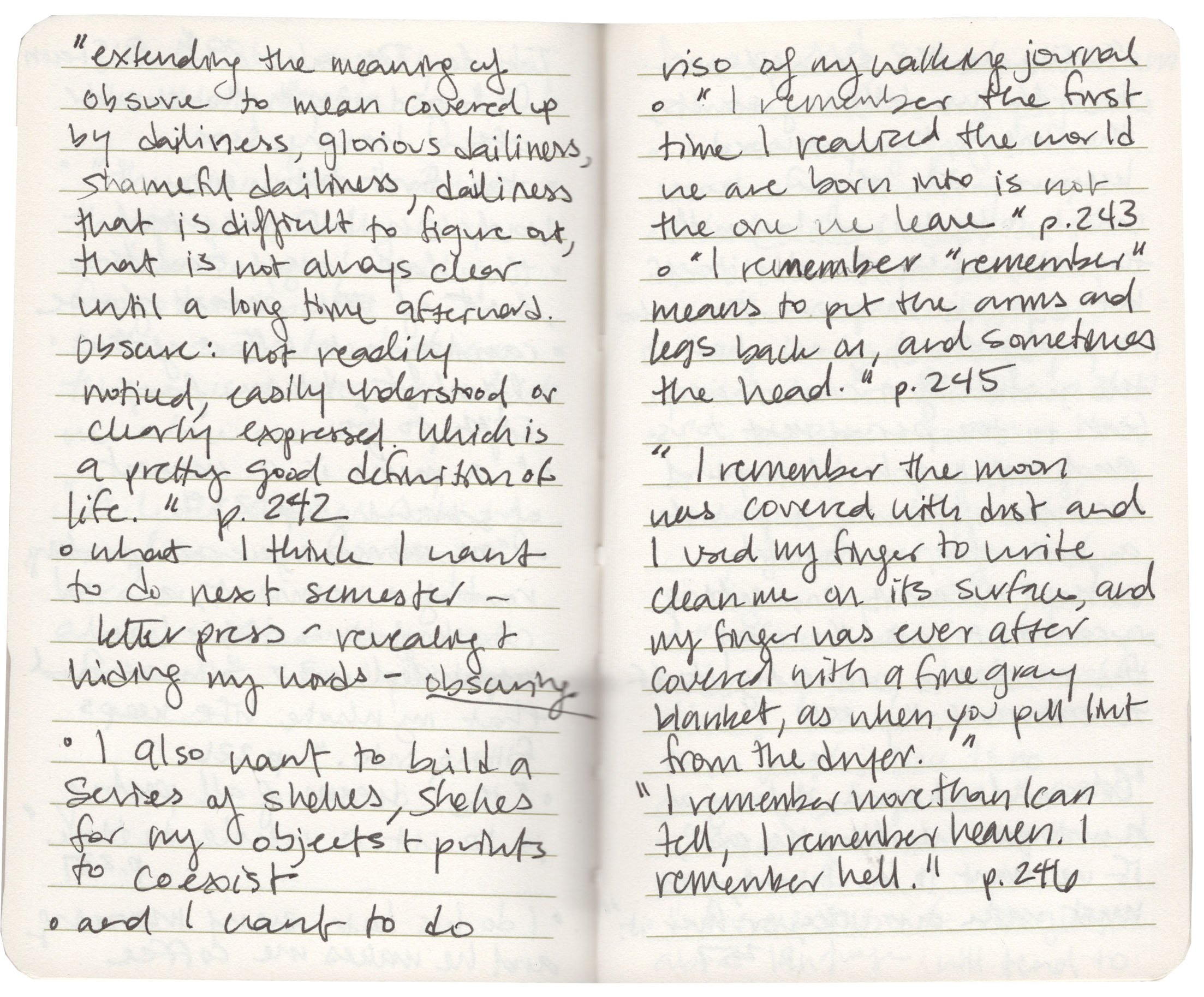Written on an oversized Post-It board were a list of prompts. It was the third option, scribbled like a math equation that piqued my interest the most: a beginning + ending = middle.
This prompt was an invitation provided by artist and educator Elizabeth Malaska in her recent workshop: Advanced Studio Seminar with WildCraft Studio School. Given as a homework assignment to help six strangers practice discussing our artwork and uncovering the intentions behind our art practices; these suggestions for places to begin were meant to prepare us for our upcoming group critiques.
I was eager to approach the question of how to talk about my work with a writing exercise, especially one shaped as if it were a Venn Diagram, searching for how a middle could link a found beginning to a found ending.
Wednesday, March 29th 9:16 am
Testing out the prompt, I started with Olivia Laing’s book Funny Weather Art in an Emergency. I suppose I started here, because when I am lost, I instinctually turn to my bookshelf. Laing’s title that links the words funny, weather, and emergency felt like its own beginning + ending = middle.
Opening the book to a random page – pg. 159. With my eyes closed, I pointed. I landed on “…her decision to return home to her abusive family caused what [Sarah] Lucas describes as the ‘great schism’ of her mother’s psyche.” Dipping my toes in, I took only a section of this loaded sentence and began with cutting and cropping the phrase: to return home.
To return home—what and where is a home? Home is more than shelter. I want my home to be a place where love resides. I imagine it to be a cozy corner with a window view, nestled under a lamp, safe and warm between the cushions. Homes are made of multiple places, textures, and smells; places of memories, but these foundations can be disappointingly fleeting, unreliable or missing altogether. A home is a place of intimate rituals and habits—both those that you run from and those you embrace…I think both.
Sentence two is from Bluets by Maggie Nelson. I found page 67 with my eyes closed again and pointed to: “I think both the theatre and we ourselves have had enough of psychology.” (Artuad)
And with this I took only: I think both.
Curious, I switched the order of the books. Beginning now with Bluets, my first sentence is from page 5, “The most I want to do is show you the end of my index finger.”
The most I want to do is show you the end of my index finger. The end of a finger is a measurement, an approximation, a referential living scale of comparison, but also idiosyncratic with lines of patterns identifying who you are, what you point to, where you go, and what you touch. At the end of a fingertip is a visceral essay of years told.
Sentence two is from Funny Weather, page 73, the first sentence on the page: “Knives opens with a visceral essay about Wojnaronicz’s homelessness years: a boy in glasses selling his skinny body to the pedophiles and creeps who hung around Times Square.”
Is it possible for me to use the entire sentence? I recognize my inclination to crop and edit, untethering authors’ words from their original home in a sentence, plucked from the paragraph.
What came up for me with this exercise is the word: home. Home was mentioned in recent conversations about the importance of decorating the spaces where you live. The difference a rug makes in a room after two and a half years of living with bare floors exposed and naked. Now my feet finally feel the warmth of tufted textiles and I can begin to understand what J meant when she said:
“As artists, we are more sensitive to our surroundings.”
The late artist and AIDS activist, David Wojnarowicz had also resurfaced for me recently. On a day when I was feeling low energy, but my mind was still active, craving engagement, I found myself lying in bed, watching All The Beauty And The Bloodshed, a Nan Goldin documentary, featuring Wojnarowicz.
The camera framed his face to fill my laptop’s screen while he discussed the atrocities of AIDS and smoked cigarettes from inside his apartment. Before you are ready (although no one was or is ever ready), the scene shifts from the smoke in the air to Goldin mourning Wojnarowicz’s death.
fluid lowercase, 2023
These coincidences reiterated the purpose of this writing prompt as a chance and choice exercise. I chose the books, finding the pages by chance. I chose the words to crop from their sentences, but the sentences appeared by closing my eyes and pointing. The books I open and close, the people I converse with, and the documentaries I watch, all collect in my periphery and inevitably fall into my research.
Each of these chances are in step with my choices.
Throughout the workshop, Malaska emphasized paying attention to what fills our peripheries. For me this means returning to the writing of Moyra Davey and the phrase ‘the social life of a book.’ Much of Davey’s writing is finding connections between other writers’ sentences across time and past the page— where they exist in our day to day. Two found sentences are how books talk to each other.
Sometimes these peripheries are faraway conversations that question your memory. Like the time I found Heidi Julavits’ book, The Folded Clock: A Diary staring at me from the shelf at a local gallery that is also bookstore. The words ‘a folded clock’ felt familiar, as if they had previously been spoken, described to me as a recommendation of something I needed to read. I still don’t know if this was true or if I wished it to be. But by page 33, I began to trust that my memory had been correct when I read the author quoting a poem by Mary Ruefle—the same quote I had written down three years prior.
“An ordinary life was an obscure life, if we can extend the meaning of obscure to mean covered up by dailiness, glorious dailiness, shameful dailiness, dailiness that is difficult to figure out, that is not always clear until a long time afterward.”
Ruefle wrote the poem “I Remember, I Remember,” in 2012. Julavits wrote The Folded Clock: A Diary in 2015, quoting Ruefle’s poem under the subheading: July 16th. And on Tuesday, December 29th 2020 at 8:51 am, I wrote it down again. But just the day before on Monday December 28th at 10:18am, I also wrote the quote:
“Have you ever read a book at the right age on the right afternoon, in the right place at the right angle?”
Madness, Rack, and Honey, pg 185
Thursday March 30th – unknown time in the morning
Sentence one is taken from All About Love by bell hooks. Maybe if I take two sentences from the same book, I won’t feel the need to crop them? Each sentence is still collected with my eyes closed and my finger outstretched like I am playing the game of spinning a globe, wondering where I will randomly assign myself to travel next.
The truth is, far too many people in our culture do not know what love is. He tells me he loves me with an egg bagel sandwich or with tacos. It is a practiced ritual. Waking up each day, for years with a coffee and a kiss. Hiding a note in his luggage – a good luck wish for him to find in his pockets later. Love for me is a willingness to step outside of what is known in his world of dailiness and enter mine. To see me and what I do.
It is sharing a walk with the dog, stopping for a cappuccino and a croissant, wearing our stains and crumbs with laughter. Love for me is listening and giving my words back to me, handled carefully. For him, it is seeing a plan through, my presence felt from start to finish, but for me it is accepting and enjoying the detours. Acknowledging this meaningful link between perfect passion and perfect love from the onset of a relationship can be necessary inspiration that empowers us to choose love.
Ending with sentence two from page 179, which comes after bell hooks defines perfect passion versus perfect love.
Perfect passion: happens when we meet someone who appears to have everything we wanted to find in a partner. (We see what we want to see).
Perfect love: is when our passion gives us the courage to face reality, embrace our true selves.
Sunday April 2nd: 7:52 pm
Last week I went shopping for a surprise gift for a friend. The same friend that in my memory shared Julavits’ book with me many years before I found it without looking for it. Now in another local bookstore that is also a stationary store, I found the slim sized book, The Hole by Hiroko Oyamada.
Purchased in the afternoon, I had finished reading it by that evening. This time I didn’t close my eyes and point. I squinted and skimmed with my eyes to find the first sentence that stood out against the others.
I’m guessing no one told you about me. I don’t blame them. I probably wouldn’t either, but here I am. I am like the ants that reappear in the spring, crawling up your bathroom walls, sneaking under the towels or even in the bristles of your toothbrush. Even after you smell the ant’s smooshed body between your fingers the crawling feeling remains. I am there but I’m not. The same way the blue tape wrapped around the kitchen faucet was meant to be a temporary solution. Almost a year later, it is still there, sticking the button into place, keeping the water running.
I am like the unfinished to do list, buried, crumpled at the bottom of a coat pocket, written on a folded piece of paper. A partially crossed out to do list kissing an over chewed piece of gum, still soggy with spit. The ink smeared and the words no longer legible, maybe they never were. Together we remain lost in a closet, behind closed doors. I don’t blame them. I am the muddy shoes left in front of the door—a tripping hazard. The type of shoes you kick out of the way in annoyance as you walk by.
I am beginning to think that you only see me when you are forced to. I was wrong.
I never wrote down which page sentence two, “I was wrong,” came from, but for a short sentence, it was harder to place at the end than you might expect. It felt as if it should have been a beginning. Is an end any different than a beginning?
I found it strange that as ants began to infiltrate my house and my writing, they were also crawling across page 19-20 in the new book I was reading. Cristina Rivera Garza was narrating her visit to Azcapotzalco, one of the sixteen municipalities of Mexico City. A name which translated from the Nahuatl language means “place of anthills.” A name derived from the legend of the deity Quetzalcóatl, whose mission, after the formation of the Fifth Sun was to recreate humankind. Which meant that he had to enter Mictlán, the underworld or realm of the dead to collect the bones and skeletal remains as a way to rebuild. As I understand it, it is a creation story built on the backs of a small but disciplined army of ants.
On March 30th in a café in a neighborhood in NE Alberta shortly after 1pm
I was introduced to the book Liliana’s Invincible Summer, by Cristina Rivera Garza which was described to me as a search for justice for her sister’s murder through the act of collecting and rebuilding a missing archive. Similar to the way Davey arranges her disparate subjects under subheadings in her book Index Cards, Rivera Garza arranges her paragraphs under bracketed, lowercase subheadings like the one found on page 19:
[place of anthills]
“…the ants, which once crossed the border between life and death, slip through the skin now, linking the outside and the inside, history and event, myth and injury. A puncture. A crack…the ants climb the inner face of the body’s organs and, laboring against tissues and mucous membranes, advance steadily until they reach the most intimate crevices, the rifts. Collectors on the surface, predators under the ground. The ants have already colonized every corner of the planet and yet, clearly unsatisfied, they now travel through the lymphatic system, the large intestine, the very fine network of veins and arteries, the hidden side of the tongue.
Details of a commissioned 11’ x 7’ velvet and fibrous installation representing insides as seen on the outside made the same time that I was reading about ants linking the inside and the outside in May of 2023
There are 130 million years of history on the backs of these ants but everything happens in a blink. Time contracts. Time decomposes itself…Time elongates itself. Some eighty million years ago an ant was trapped within an amber and the fossil of Sphecomyrma freyi came into view.
Time thins out. Hymenopterans, mimetics, symphites, the words amble away and cross the border of Mictlán. Here they go, one after another, words and ants, carrying the bones of the dead on the protective shells of their exoskeletons.”
Monday, April 3rd 7:45 am
Again, I return to Oyamada’s book, because I can’t stop thinking about it. Sentence one was selected by skimming the page until I found: “there was something black at his feet.”
This time I wrote in response before finding sentence two, my unknown ending.
There was something black at his feet. It was somewhat obscured, an indistinguishable size, it’s movements slow and shadow-like. Before I could identify what I was seeing, it slipped into a nearby gutter, disappearing down the drain. I must have imagined it. For a moment, the sound of insects stopped, then started buzzing louder.
Sunday, April 9th 10:59 am
I copied the words “As if on the verge of a threshole-hold” from page 32 of Lara Mimosa Montes’ book Thresholes.
Mimosa Montes’ book shares the same title as one of artist Gordon Matta-Clark’s early “building cut” projects Bronx Floors (1972-73). Matta-Clark who referred to himself as an “anarchitect,” would dissect buildings, cutting and cropping sections, dismantling interiors by separating ceilings from walls and walls from floors— photographing each intervention.
Threshole is a diptych in this series, which highlights a cut made beneath a door, allowing viewers to imagine the type of rooms it had once been connected to. Mimosa Montes’ notes this title’s wordplay as a concept linked to the artist’s aim “to transform place into a state of mind by opening walls where doors never were.”
Judith Russi Kirshner, Christian Kravagna, Gordon Matta-Clark, (Phaidon Press Limited, 2003) 64-65 as seen on my front porch
Two found sentences are their own thresholes. Cutting and cropping creates openings, where depending on your vantage point a hole can be seen as either a view through the ceiling above or from the floor below.
While writing as a response to the prompt two found sentences, I have simultaneously been returning to a collection of vinyl letters collected off the wall at the end of my thesis exhibition. Looking at letters layered on top of one another, my eye searches for words, reading their absence.
In the beginning, I was somewhat dubious that this writing exercise would lead me back to my art practice, but here I am finding a new network of connected holes: a tunnel with new layers of complexity exposed.
And as a bonus, I am excited to say that as a new member of the artist collective, Carnation Contemporary, I will be exhibiting this series of printed mini works on paper at Form.a, an art press fair focused on artist-run spaces in Portland, OR.
On July 1st from 2-8pm at Oregon Contemporary I will be showing with fellow artists from Carnation as well as makers from many other artist-run spaces such as but not limited to: Well Well Projects, Stelo Arts, Wave Contemporary and more. Come say hi!























